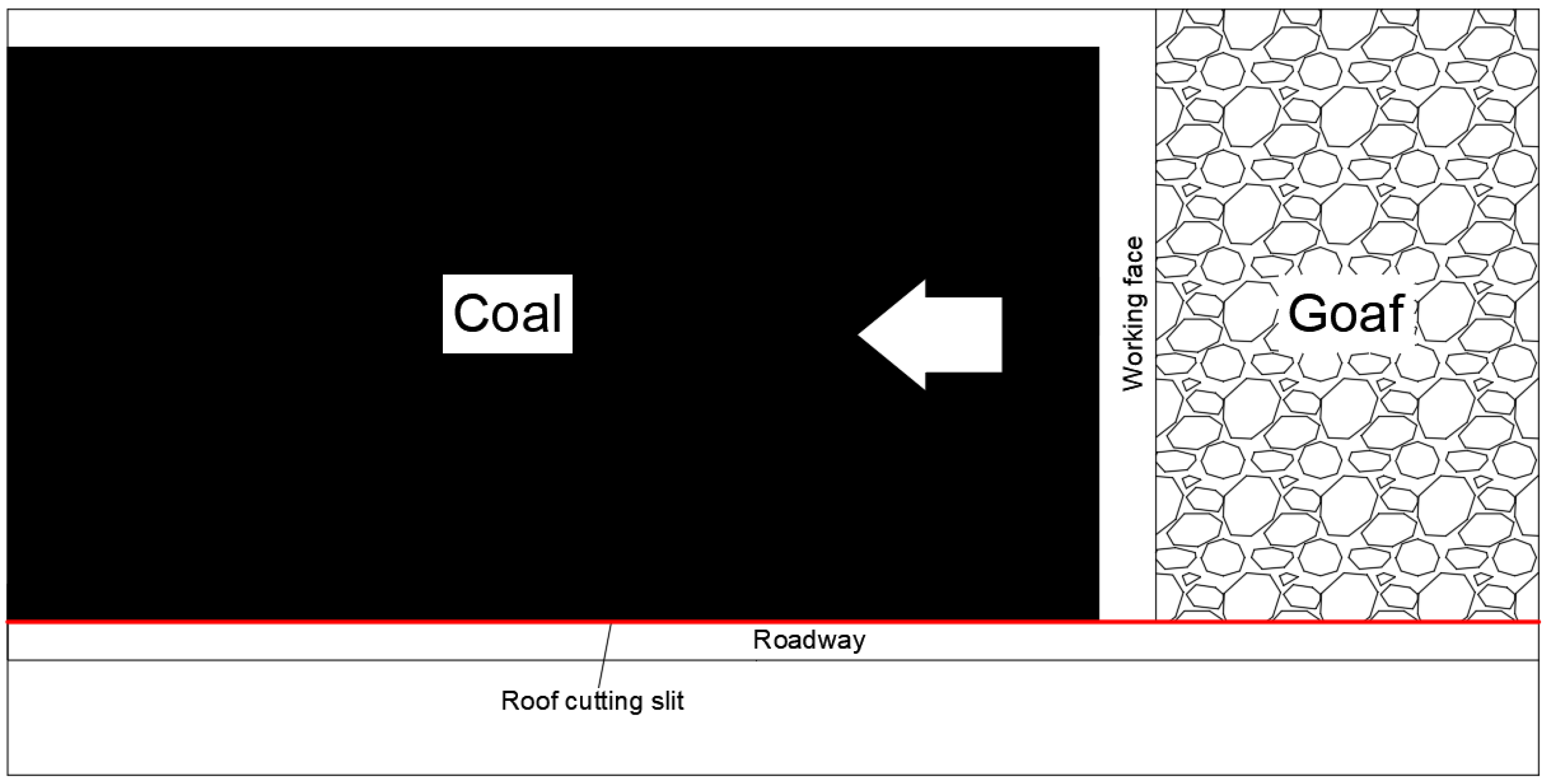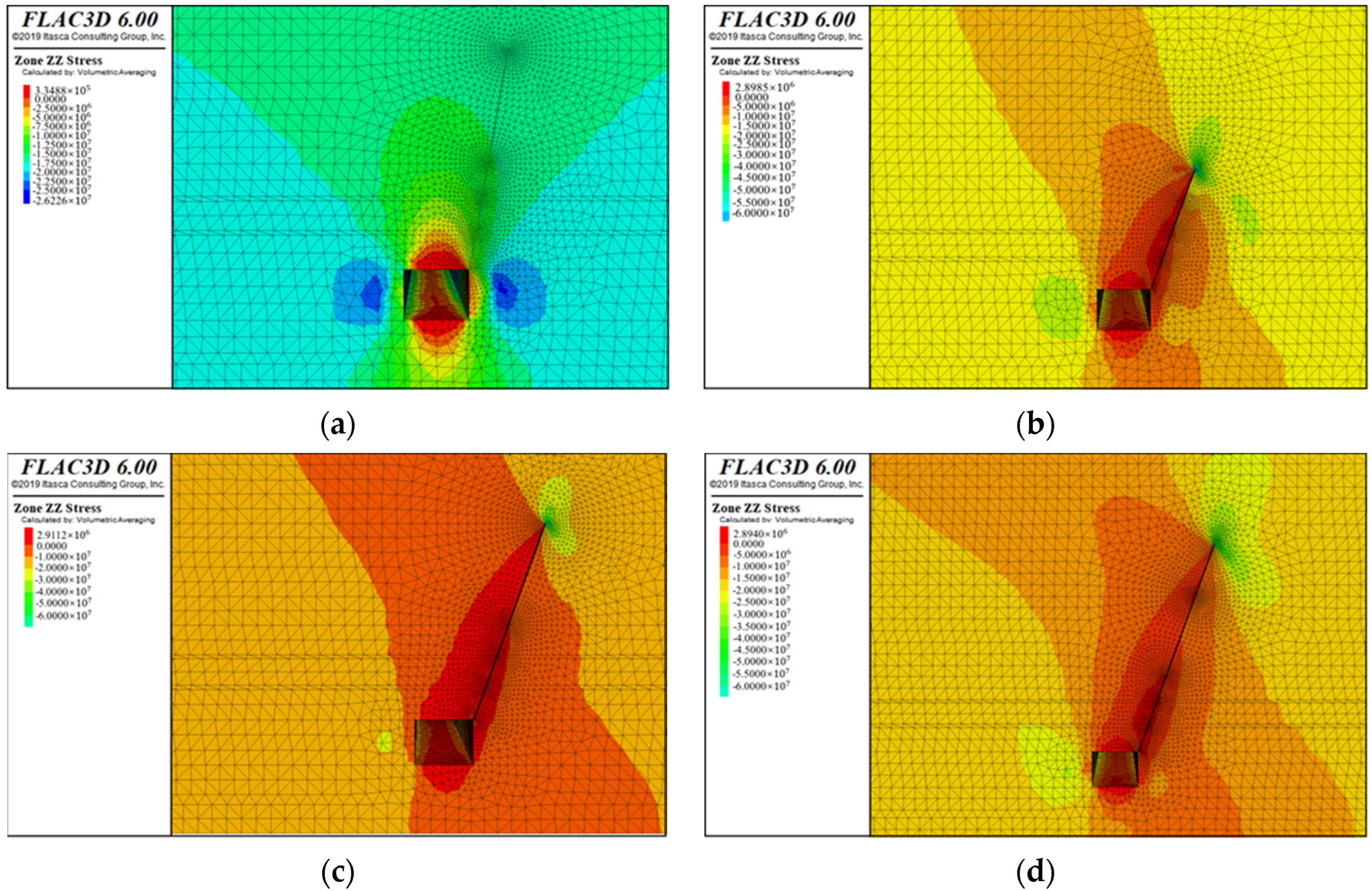Key Parameters of the Roof Cutting and Pressure Relief Technology in the Pre-Splitting Blasting of a Hard Roof in Guqiao Coal Mine
Abstract
:1. Introduction
2. Engineering Background
3. Pressure Relief Mechanism of Roof Cutting
3.1. Key Parameters of Roof Cutting Design
3.1.1. Cutting Top Height
3.1.2. Cutting Angle
4. Numerical Simulation
4.1. Model Establishment
4.2. Analysis of Roof Cutting Effect
5. Conclusions
Author Contributions
Funding
Institutional Review Board Statement
Informed Consent Statement
Data Availability Statement
Conflicts of Interest
References
- Xu, X.; Zhou, Y.; Yang, J.; Gao, Y.; Zhu, C.; Wang, Y.; Fu, Q. An Innovative Mechanism of Directional Rock Cracking Mechanics and Mine Pressure Control Method for Energy-Gathering Blasting. Rock Mech. Rock Eng. 2024, 57, 8657–8677. [Google Scholar] [CrossRef]
- Wang, M.; Zheng, H.; Ma, Z.; Mu, H.; Feng, X. Control Technology of Roof-Cutting and Pressure Relief for Roadway Excavation with Strong Mining Small Coal Pillar. Sustainability 2023, 15, 2046. [Google Scholar] [CrossRef]
- Yang, Y.; Zhang, Y. Research on the Technology of Small Coal Pillars of Gob-Side Entry Retained in Deep Mines Based on the Roof Cutting for Pressure Unloading in the Lower Key Stratum. Geofluids 2022, 2022, 7701154. [Google Scholar] [CrossRef]
- Zhu, Q.; Xue, F.; Bai, G.; Li, T.; Wang, B.; Zhao, J. An exploration of improving the stability of mining roadways constructed in soft rock by roof cutting and stress transfer: A case study. Eng. Fail. Anal. 2024, 157, 107898. [Google Scholar] [CrossRef]
- Zhu, Q.; Li, T.; Lou, Q.; Liu, Y.; Li, C.; Chen, J. Stability mechanisms of soft rock mining roadways through roof cutting and pressure relief: An exploratory model experiment. Front. Ecol. Evol. 2023, 11, 1237894. [Google Scholar] [CrossRef]
- Huang, L.; Yang, S.; Xu, Y.; Luo, Y.; Yuan, H. Comprehensive Monitoring Research on the Effect of Roof Cutting and Pressure Release: A Case Study of the Jiulishan Coal Mine in China. Geofluids 2022, 2022, 9752767. [Google Scholar] [CrossRef]
- Wang, T.; Xu, G.; Liu, L.; Bai, C.; Ye, W.; Sun, L. Principle and practice of hydraulic softening top-cutting and pressure relief technology in weakly cemented strata. Front. Earth Sci. 2024, 12, 1367933. [Google Scholar] [CrossRef]
- Liu, J.; He, M.; Guo, S.; Li, J.; Zhou, P.; Zhu, Z. Study on characteristics of pressure relief by roof cutting under nonpillar-mining approach. Bull. Eng. Geol. Environ. 2022, 81, 441. [Google Scholar] [CrossRef]
- Zhu, Z.; Wu, Y.; Liang, Z. Mining-Induced Stress and Ground Pressure Behav ior Characteristics in Mining a Thick Coal Seam With Hard Roofs. Front. Earth Sci. 2022, 10, 843191. [Google Scholar] [CrossRef]
- Liu, W.; Yang, K.; He, X.; Zhang, Z.; Xu, R. Mechanism and Control Technology of Rockburst Induced by Thick Hard Roof and Residual Coal Pillar: A Case Study. Geofluids 2023, 2023, 3523592. [Google Scholar] [CrossRef]
- Kong, P.; Liu, C.; Yang, D.; Shihui, L.; Ruiju, J. Mechanism of Roof Cutting and Stress Relief in Coal Seams with Hard Sandstone Coverage. Geotech. Geol. Eng. 2024, 42, 5251–5267. [Google Scholar] [CrossRef]
- Wang, H.; Wang, J.; Elmo, D.; He, M.; Ma, Z.; Gao, C. Ground response mechanism of entries and control methods induced by hard roof in longwall top coal caving panel. Eng. Fail. Anal. 2023, 144, 106940. [Google Scholar] [CrossRef]
- Huang, X.; Zhang, C.; Ren, Z. Parameter determination and effect evaluation of gob-side entry retaining by directional roof cutting and pressure releasing. Eng. Fail. Anal. 2024, 156, 107847. [Google Scholar] [CrossRef]
- Hao, Y.; Li, M.; Wang, W.; Zhang, Z.; Li, Z. Study on the Stress Distribution and Stability Control of Surrounding Rock of Reserved Roadway with Hard Roof. Sustainability 2023, 15, 14111. [Google Scholar] [CrossRef]
- Zhang, K.; Liu, C.; Zhang, H.; Yue, X.; Liu, H. Research on Roof Cutting Pressure Relief of the Gob-Side Entry Retaining With Roadside Backfilling. Front. Earth Sci. 2022, 10, 835497. [Google Scholar] [CrossRef]
- Wang, Y.; Wang, Q.; Tian, X.; Wang, H.; Yang, J.; He, M. Stress and deformation evolution characteristics of gob-side entry retained by roof cutting and pressure relief. Tunn. Undergr. Space Technol. Inc. Trenchless Technol. Res. 2022, 123, 104419. [Google Scholar] [CrossRef]
- Sun, B.J.; Hua, X.Z.; Zhang, Y.; Yin, J.; He, K.; Zhao, C.; Li, Y. Analysis of Roof Deformation Mechanism and Control Measures with Roof Cutting and Pressure Releasing in Gob-Side Entry Retaining. Shock. Vib. 2021, 2021, 6677407. [Google Scholar] [CrossRef]
- He, J.; Dou, L.; Gong, S.; Li, J.; Ma, Z. Rock burst assessment and prediction by dynamic and static stress analysis based on micro-seismic monitoring. Int. J. Rock Mech. Min. Sci. 2017, 93, 46–53. [Google Scholar] [CrossRef]
- Gao, F.; Zhou, K.P.; Dong, W.J.; Su, J.H. Similar material simulation of time series system for induced caving of roof in continuous mining under backfill. J. Cent. South Univ. Technol. 2008, 15, 356–360. [Google Scholar] [CrossRef]
- Hu, J.H.; Zhou, K.P.; Li, X.B.; Yang, N.G.; Su, J.H. Numerical analysis of application for induction caving roof. J. Cent. South Univ. Technol. 2005, 12, 46–149. [Google Scholar] [CrossRef]
- Guo, X.; Zheng, X.; Li, P.; Lian, R.; Liu, C.; Shahani, N.M.; Wang, C.; Li, B.; Xu, W.; Lai, G. Full-stress anchoring technology and application of bolt s in the coal roadway. Energies 2021, 14, 7475. [Google Scholar] [CrossRef]
- Ma, X.; Li, G.; Cao, H.; Wang, H.; Shi, X.; Zhao, Q.; Han, Z.; Zhang, T.; Dai, W.; Zhang, J. Study on the Support System Mechanism of Entry Roof with Roof Cutting Pressure Releasing Gob-Side Entry Retaining Technology. Adv. Civ. Eng. 2022, 2022, 5366168. [Google Scholar] [CrossRef]










| Roof and Floor Parameters | Rock Name | Thickness/m | Rock Characteristics |
|---|---|---|---|
| Upper roof | Fine sandstone, sandy mudstone | 9.00 | White, thick layers, fine-grained structure, fracture development, siliceous and calcareous cementation, with horizontal and cross bedding; gray to grayish white, argillaceous cementation, contains plant fragments, dense |
| Immediate roof | Mudstone, carbonaceous mudstone, 11-3 coal | 4.50 | Gray to dark gray, argillaceous cementation, brittle and fragile, sliding surface development, with a sense of sliding; top is 11-3 coal seam, black, powdery |
| Immediate bottom | Mudstone, 11-1 coal | 4.68 | Gray to dark gray, argillaceous cementation, brittle and easy to fall, sliding surface development, with a sense of sliding; bottom is 11-1 coal seam, black, powdered, small fragments |
| Old bottom | Sandy mudstone, siltstone | 5.15 | Gray to dark gray, argillaceous cementation, brittle and fragile; gray-white, thick layer, silt structure, fracture development, siliceous and calcareous cementation, with horizontal and cross bedding |
| Rock Name | Volumetric Weight d/(kg/m3) | Bulk Modulus K/GPa | Shear Modulus G/GPa | Cohesion /MPa | Angle of Internal Friction/° | Compressive Strength /MPa | Tensile Strength /MPa |
|---|---|---|---|---|---|---|---|
| Fine sandstone | 2800 | 7.00 | 3.50 | 6.20 | 31 | 126.5 | 6.70 |
| Sandy mudstone | 2510 | 5.70 | 4.30 | 2.90 | 36 | 40.3 | 3.80 |
| Mudstone | 2250 | 4.39 | 2.20 | 2.60 | 28 | 38.6 | 3.20 |
| Carbon mudstone | 2310 | 5.10 | 2.70 | 2.42 | 33 | 34.7 | 2.90 |
| 11-2 coal | 1420 | 2.30 | 1.30 | 1.25 | 30 | 12.5 | 2.30 |
| Siltstone | 2700 | 6.50 | 4.00 | 6.00 | 35 | 80.5 | 5.60 |
Disclaimer/Publisher’s Note: The statements, opinions and data contained in all publications are solely those of the individual author(s) and contributor(s) and not of MDPI and/or the editor(s). MDPI and/or the editor(s) disclaim responsibility for any injury to people or property resulting from any ideas, methods, instructions or products referred to in the content. |
© 2024 by the authors. Licensee MDPI, Basel, Switzerland. This article is an open access article distributed under the terms and conditions of the Creative Commons Attribution (CC BY) license (https://creativecommons.org/licenses/by/4.0/).
Share and Cite
You, H.; Liu, Z. Key Parameters of the Roof Cutting and Pressure Relief Technology in the Pre-Splitting Blasting of a Hard Roof in Guqiao Coal Mine. Appl. Sci. 2024, 14, 11779. https://doi.org/10.3390/app142411779
You H, Liu Z. Key Parameters of the Roof Cutting and Pressure Relief Technology in the Pre-Splitting Blasting of a Hard Roof in Guqiao Coal Mine. Applied Sciences. 2024; 14(24):11779. https://doi.org/10.3390/app142411779
Chicago/Turabian StyleYou, Hanlin, and Zegong Liu. 2024. "Key Parameters of the Roof Cutting and Pressure Relief Technology in the Pre-Splitting Blasting of a Hard Roof in Guqiao Coal Mine" Applied Sciences 14, no. 24: 11779. https://doi.org/10.3390/app142411779
APA StyleYou, H., & Liu, Z. (2024). Key Parameters of the Roof Cutting and Pressure Relief Technology in the Pre-Splitting Blasting of a Hard Roof in Guqiao Coal Mine. Applied Sciences, 14(24), 11779. https://doi.org/10.3390/app142411779





